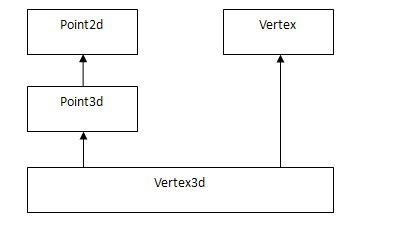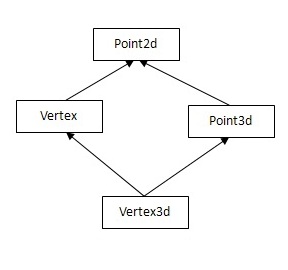使用GDB來理解C++ 對象的內存佈局(多重繼承,虛繼承)
前一段時間再次拜讀《Inside the C++ Object Model》 深入探索C++對象模型,有了進一步的理解,因此我也寫了四篇博文算是讀書筆記:
Program Transformation Semantics (程序轉換語義學)
The Semantics of Copy Constructors(拷貝構造函數之編譯背後的行為)
The Semantics of Constructors: The Default Constructor (默認構造函數什麼時候會被創建出來)
The Semantics of Data: Data語義學 深入探索C++對象模型
這些文章都獲得了很大的瀏覽量,雖然類似的博文原來都有,可能不容易被現在仍活躍在CSDN Blog的各位同仁看到吧。因此萌生了接著將這這本書讀完的同時,再接著談一下我的理解,或者說讀書筆記。
關於C虛函數,很多博文從各個角度來探究虛函數是如何實現的,或者說編譯器是如何實現虛函數的。比較經典的文章有陳皓先生的《C++虛函數表解析》和《C++對象內存佈局》。本文通過GDB來從另外一個角度來理解C object的內存佈局,一來熟悉語言背後編譯器為了實現語言特性為我們做了什麼;二來熟悉使用GDB來調試程序。
同時,本文也將對如何更好的理解C語言提供了一個方法:使用GDB,可以很直觀的理解編譯器的實現,從根本上掌握C!我們不單單隻會開車,還應該知道車的內部的構造。
2、帶有虛函數的單一繼承
class Parent
{
public:
Parent():numInParent(1111)
{}
virtual void Foo(){
};
virtual void Boo(){
};
private:
int numInParent;
};
class Child: public Parent
{
public:
Child():numInChild(2222){}
virtual void Foo(){
}
int numInChild;
};
編譯時不要忘記-g,使得gdb可以把各個地址映射成函數名。
(gdb) set p obj on
(gdb) p *this
$2 = (Child) {<Parent> = {_vptr.Parent = 0x400a30, numInParent = 1111}, numInChild = 2222}
(gdb) set p pretty on
(gdb) p *this
$3 = (Child) {
<Parent> = {
_vptr.Parent = 0x400a30,
numInParent = 1111
},
members of Child:
numInChild = 2222
}
(gdb) p /a (*(void ***)this)[0]@3
$4 = {0x4008ec <Child::Foo()>, 0x4008b4 <Parent::Boo()>, 0x6010b0 <_ZTVN10__cxxabiv120__si_class_type_infoE@@CXXABI_1.3+16>}
解釋一下gdb的命令: set p obj <on/off>: 在C++中,如果一個對象指針指向其派生類,如果打開這個選項,GDB會自動按照虛方法調用的規則顯示輸出,如果關閉這個選項的話,GDB就不管虛函數表了。這個選項默認是off。 使用show print object查看對象選項的設置。
set p pertty <on/off>: 按照層次打印結構體。可以從設置前後看到這個區別。on的確更容易閱讀。
p /a (*(void ***)this)[0]@3 就是打印虛函數表了。因為知道是兩個,可以僅僅打印2個元素。為了知道下一個存儲了什麼信息,我們打印了3個值。實際上後幾個元素存儲了Parent 和Child的typeinfo name和typeinfo。
總結:
對於單一繼承,
1. vptr存儲到了object的開始。
2. 在vptr之後,從Parent開始的data member按照聲明順序依次存儲。
3. 多重繼承,包含有相同的父類
對應的C++codes:
class Point2d{
public:
virtual void Foo(){}
virtual void Boo(){}
virtual void non_overwrite(){}
protected:
float _x, _y;
};
class Vertex: public Point2d{
public:
virtual void Foo(){}
virtual void BooVer(){}
protected:
Vertex *next;
};
class Point3d: public Point2d{
public:
virtual void Boo3d(){}
protected:
float _z;
};
class Vertex3d: public Vertex, public Point3d{
public:
void test(){}
protected:
float mumble;
};
使用GDB打印的對象內存佈局:
<Vertex> = {
<Point2d> = {
_vptr.Point2d = 0x400ab0,
_x = 5.88090213e-39,
_y = 0
},
members of Vertex:
next = 0x0
},
<Point3d> = {
<Point2d> = {
_vptr.Point2d = 0x400ae0,
_x = -nan(0x7fe180),
_y = 4.59163468e-41
},
members of Point3d:
_z = 0
},
members of Vertex3d:
mumble = 0
}
可見v3d有兩個vptr,指向不同的vtable。首先看一下第一個:
(gdb) p /a (*(void ***)this)[0]@5
$9 = {0x4008be <Vertex::Foo()>,
0x4008aa <Point2d::Boo()>,
0x4008b4 <Point2d::non_overwrite()>,
0x4008c8 <Vertex::BooVer()>,
0xffffffffffffffe8}
(gdb) p /a (*(void ***)this)[0]@6
$10 = {0x4008be <Vertex::Foo()>,
0x4008aa <Point2d::Boo()>,
0x4008b4 <Point2d::non_overwrite()>,
0x4008c8 <Vertex::BooVer()>,
0xffffffffffffffe8,
0x400b00 <_ZTI8Vertex3d>}
(gdb) info addr _ZTI8Vertex3d
Symbol "typeinfo for Vertex3d" is at 0x400b00 in a file compiled without debugging.
你可以注意到了,vtable打印分行了,可以使用 set p array on將打印的數組分行,以逗號結尾。
注意到該虛函數表以 0xffffffffffffffe8 結尾。
在單一繼承中是沒有這個結束標識的。 接著看第二個vtable:
(gdb) p /a (*(void ***)this)[1]@5
$11 = {0x4008b2 <Point2d::Boo()>,
0x4008bc <Point2d::non_overwrite()>,
0x4008d0 <Vertex::BooVer()>,
0xffffffffffffffe8,
0x400b00 <_ZTI8Vertex3d>}
(gdb) info addr _ZTI8Vertex3d
Symbol "typeinfo for Vertex3d" is at 0x400b00 in a file compiled without debugging.
當然這個只是為了舉個例子。現實中很少有人這麼幹吧。比如訪問Foo,下面的code將會導致歧義性錯誤:
v3d.Boo();
error: request for member Boo is ambiguous multiInheritance.cpp:8: error: candidates are: virtual void Point2d::Boo() 只能指定具體的subobject才能進行具體調用:
v3d.::Vertex::Boo();
4. 虛擬繼承
C++ codes:
class Point2d{
public:
virtual void Foo(){}
virtual void Boo(){}
virtual void non_overwrite(){}
protected:
float _x, _y;
};
class Vertex: public virtual Point2d{
public:
virtual void Foo(){}
virtual void BooVer(){}
protected:
Vertex *next;
};
class Point3d: public virtual Point2d{
public:
virtual void Boo3d(){}
protected:
float _z;
};
class Vertex3d: public Vertex, public Point3d{
public:
void test(){}
protected:
float mumble;
};
繼承關係圖:
使用gdb打印object的內存佈局:
(gdb) p *this
$10 = (Vertex3d) {
<Vertex> = {
<Point2d> = {
_vptr.Point2d = 0x400b70,
_x = 0,
_y = 0
},
members of Vertex:
_vptr.Vertex = 0x400b18,
next = 0x4009c0
},
<Point3d> = {
members of Point3d:
_vptr.Point3d = 0x400b40,
_z = 5.87993804e-39
},
members of Vertex3d:
mumble = 0
}
gdb打印的vptr相關:
(gdb) p /a (*(void ***)this)[0]@60
$25 = {0x400870 <Vertex::Foo()>,
0x40087a <Vertex::BooVer()>,
0x10,
0xfffffffffffffff0,
0x400c80 <_ZTI8Vertex3d>, #"typeinfo for Vertex3d"
0x400884 <Point3d::Boo3d()>,
0x0,
0x0,
0xffffffffffffffe0,
0xffffffffffffffe0,
0x400c80 <_ZTI8Vertex3d>, #"typeinfo for Vertex3d"
0x400866 <_ZTv0_n24_N6Vertex3FooEv>, #"virtual thunk to Vertex::Foo()"
0x400852 <Point2d::Boo()>,
0x40085c <Point2d::non_overwrite()>,
0x0,
0x0,
0x0,
0x20,
0x0,
0x400cc0 <_ZTI6Vertex>, #"typeinfo for Vertex"
0x400870 <Vertex::Foo()>,
0x40087a <Vertex::BooVer()>,
0x0,
0x0,
0xffffffffffffffe0,
0xffffffffffffffe0,
0x400cc0 <_ZTI6Vertex>, #"typeinfo for Vertex"
0x400866 <_ZTv0_n24_N6Vertex3FooEv>, #"virtual thunk to Vertex::Foo()"
0x400852 <Point2d::Boo()>,
0x40085c <Point2d::non_overwrite()>,
0x0,
0x0,
0x0,
0x10,
0x0,
0x400d00 <_ZTI7Point3d>, #"typeinfo for Point3d"
0x400884 <Point3d::Boo3d()>,
0x0,
0x0,
0x0,
0xfffffffffffffff0,
0x400d00 <_ZTI7Point3d>, #"typeinfo for Point3d"
0x400848 <Point2d::Foo()>,
0x400852 <Point2d::Boo()>,
0x40085c <Point2d::non_overwrite()>,
0x6020b0 <_ZTVN10__cxxabiv121__vmi_class_type_infoE@@CXXABI_1.3+16>,
0x400d28 <_ZTS8Vertex3d>,
0x200000002,
0x400cc0 <_ZTI6Vertex>, #"typeinfo for Vertex"
0x2,
0x400d00 <_ZTI7Point3d>, #"typeinfo for Point3d"
0x1002,
0x0,
0x6020b0 <_ZTVN10__cxxabiv121__vmi_class_type_infoE@@CXXABI_1.3+16>,
0x400d32 <_ZTS6Vertex>,
0x100000000,
0x400d40 <_ZTI7Point2d>,
0xffffffffffffe803,
0x0,
0x0}
有興趣的話可以看一下反彙編的vtable的構成。
###參考:
1. http://stackoverflow.com/questions/6191678/print-c-vtables-using-gdb
2. http://stackoverflow.com/questions/18363899/how-to-display-a-vtable-by-name-using-gdb

